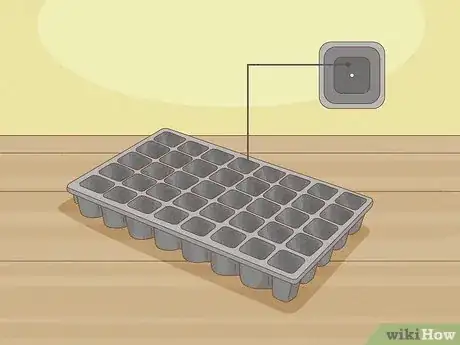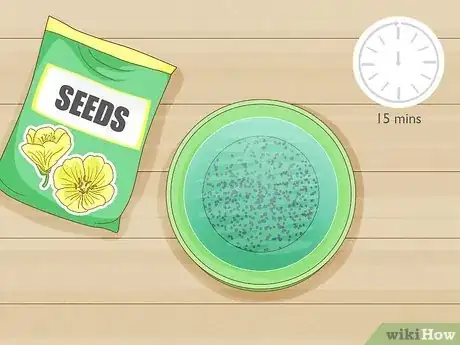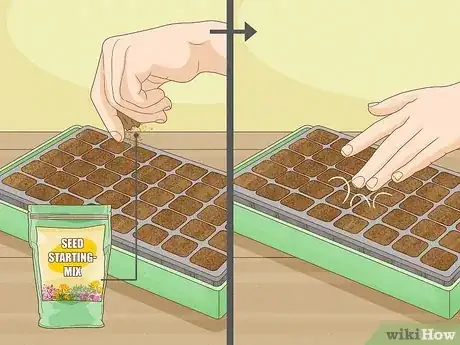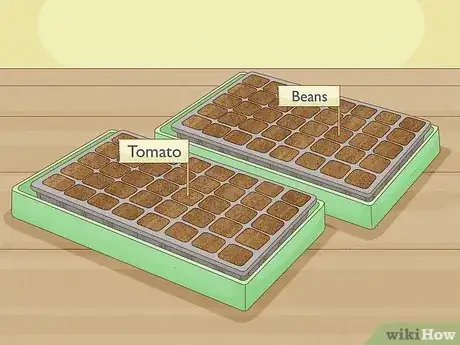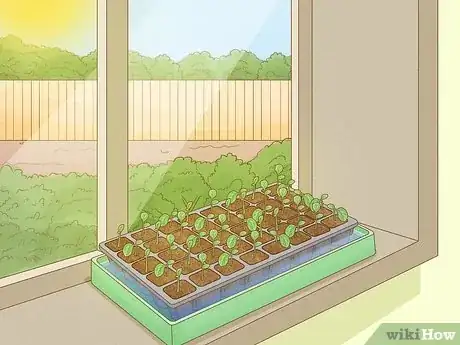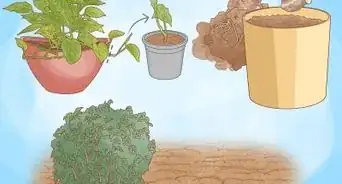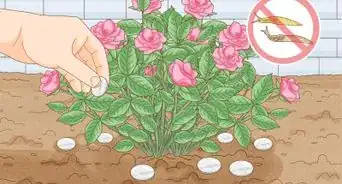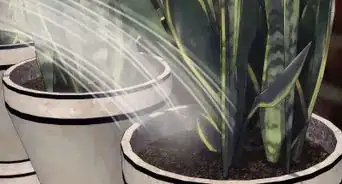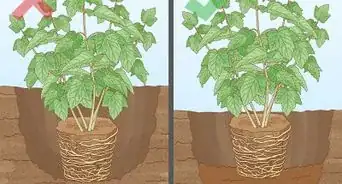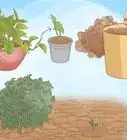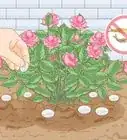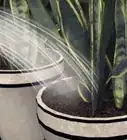This article was co-authored by Maggie Moran and by wikiHow staff writer, Hunter Rising. Maggie Moran is a Professional Gardener in Pennsylvania.
wikiHow marks an article as reader-approved once it receives enough positive feedback. In this case, several readers have written to tell us that this article was helpful to them, earning it our reader-approved status.
This article has been viewed 486,050 times.
Planting seeds is a great way to start plants indoors for your garden. Using seed trays helps your plants grow easily and with minimal effort. By getting your seeds ready for the spring, you’ll have seedlings ready to go outside in no time!
Steps
Creating a Grow Area
-
1Plan to start planting seeds between 6-12 weeks before the last frost date. Actual growing time for seeds will depend on what plants you’ve decided to grow. Planning around the last frost date for your area will help you determine when to start germinating the seeds.[1]
- Read the packaging on the seeds you are planting to see if additional steps, such as soaking or chilling, need to be taken before they are planted.
- Check the Old Farmer’s Almanac for growing dates specific for your region.
-
2Purchase a cell tray with drainage holes for an easy option. Using a cell tray allows the seeds to grow without interfering with one another. Opt for cell trays that have drainage holes at the bottom if you can. They can be purchased at any gardening store.[2]
- If your cell trays do not have drainage holes at the bottom, use a knife to poke holes in the bottom of each cell.
Advertisement -
3Make a seed tray out of a cardboard egg carton for a free alternative. This biodegradable option has perfect sized cells for planting and you may already have one in your home. After you’ve used all the eggs in a carton, poke a few holes at the bottom of each cell so the soil has good drainage.[3]
-
4Place the cell tray inside a large, flat plastic tray. The flat tray will make it easier to transport and water your seedlings. Since you’ll want your seeds to establish roots, you’ll be watering in the flat tray to promote downward growth. The plastic trays can be purchased at any gardening store.[4]
- A baking pan is an alternative that you may already have in your home.[5]
-
5Fill each cell to the top with a seed starting mix. Seed starting mix is a sterile alternative to potting soil that will help promote germination for your seeds and can be purchased in stores or online. It’s okay if you overfill since the mix will set further once it is wet.[6]
- Potting soil can be used, but it may be more coarse and the seeds may not grow as well as they would in a fine seed mix.[7]
-
6Wet the seed starting mix with a watering can. Push your finger into the soil to your first knuckle and make sure it is damp. Excess water should drain through into the tray underneath your cells.[8]
Sowing the Seeds
-
1Submerge old seeds for 15 minutes in water to see if they are still viable. If you have old seed packets you are hoping to plant, you’ll want to test if the seeds are still good to grow. Some seeds can last for years, but others will have a shorter shelf life. If any seeds float, then they will most likely not grow. If the seeds sink, they should still be good to plant.[9]
- Alternatively, you can run a germination test by wrapping at least 10 seeds in a damp paper towel. Keep the paper towel in a resealable plastic bag in a warm place for 10 days. Check the seeds to see if they’ve germinated or sprouted. If 5 or more sprout, the rest of the seeds should be viable.
-
2Poke a 1⁄4 inch (6.4 mm) deep hole in each cell with your finger. The measurement doesn’t have to be precise, so half the length of a fingernail is a good estimate. Be gentle as you press so you don’t pack the soil firm.[10]
- Some seeds may need to be set shallower or deeper, so follow the instructions on the seed packages for each plant.
-
3Plant at least 2 seeds in each hole. This helps make sure at least one of the seeds will germinate in each cell. If both of the seeds start to grow, you can always cut back or remove the weakest looking plant.[11]
- Plant 4 seeds if they are small. This gives more chances for them to grow.
- If you’re working with small seeds, pour the seeds into the crease of a folded piece of paper and use a pencil to push the seeds into the hole.[12]
-
4Cover the seeds with seed starter mix and press it down with your finger. This makes sure the seed has complete contact with the starter mix. Be gentle as you press down. You do not want to push the seed in deeper; you just want to pack the soil closer.[13]
-
5Label the seeds if you plant more than one kind. Make garden labels for your plants, listing what is growing in the cells as well as the date you planted them. Stick the labels at the end of each row.[14]
- Using toothpicks and masking tape is an easy alternative for garden labels that you can make at home.
Caring for Your Seedlings
-
1Cover the tray with plastic wrap. Plastic wrap will help keep the moisture in the tray for longer and create a humid environment that promotes germination. Leave small openings on the sides of the tray so air can still circulate to your seeds.[15]
- You can also purchase a humidity dome from a gardening store for the same effect. If the dome has an air vent, keep it open for air flow.
-
2Fill the flat tray with 1⁄2 inch (13 mm) of distilled water. The cells will soak up water from the tray so you do not have to water your seeds from the top. Check the levels of the water in the tray daily.[16]
- Fill the tray back to 1⁄2 inch (13 mm) of water when levels are below 1⁄8 inch (3.2 mm) deep.
- If you overfill the tray, the roots of your seedling may become waterlogged and develop rot.
-
3Store the tray in a warm area. Sunlight is not essential for seeds to grow, but it will not hurt them either. Keep the tray in the warmest area of your home. The soil temperature should stay above 65 °F (18 °C) for most plants to successfully germinate.[17]
- Soil temperature can be measured with a soil thermometer placed at the same depth as the seeds.
-
4Move the tray to a sunlit area once seedlings sprout and uncover them. Once you see sprouts in your cells, move your tray to a windowsill or an area with about 6 hours of indirect sunlight. Remove the plastic wrap or humidity cover so your seedlings can get full exposure to the light.[18]
- Turn your tray 180° every other day so your seedlings do not grow crooked.
- You can also keep seedlings under grow lamps so the plants will grow evenly.
Expert Q&A
Did you know you can get expert answers for this article?
Unlock expert answers by supporting wikiHow
-
QuestionCan you germinate seeds in soil?
 Maggie MoranMaggie Moran is a Professional Gardener in Pennsylvania.
Maggie MoranMaggie Moran is a Professional Gardener in Pennsylvania.
Home & Garden Specialist
-
QuestionHow long do seeds need to dry before planting?
 Maggie MoranMaggie Moran is a Professional Gardener in Pennsylvania.
Maggie MoranMaggie Moran is a Professional Gardener in Pennsylvania.
Home & Garden Specialist
-
QuestionCan you start seeds in egg cartons?
 Maggie MoranMaggie Moran is a Professional Gardener in Pennsylvania.
Maggie MoranMaggie Moran is a Professional Gardener in Pennsylvania.
Home & Garden Specialist
Things You’ll Need
- Cell tray
- Plastic garden tray
- Watering can
- Seed starting mix
- Plastic wrap or humidity dome
- Garden labels
References
- ↑ https://www.todayshomeowner.com/when-to-start-vegetable-seeds-indoors-for-spring-planting/
- ↑ https://www.veggiegardener.com/threads/how-to-start-vegetable-seeds-in-a-seed-tray.1865/
- ↑ https://www.gardenbetty.com/the-no-brainer-guide-to-starting-seeds-indoors/
- ↑ https://www.veggiegardener.com/threads/how-to-start-vegetable-seeds-in-a-seed-tray.1865/
- ↑ https://www.gardenbetty.com/the-no-brainer-guide-to-starting-seeds-indoors/
- ↑ https://www.veggiegardener.com/threads/how-to-start-vegetable-seeds-in-a-seed-tray.1865/
- ↑ http://msue.anr.msu.edu/news/potting_soils_and_seed_starting_mixes_for_your_garden
- ↑ https://www.veggiegardener.com/threads/how-to-start-vegetable-seeds-in-a-seed-tray.1865/
- ↑ http://www.hortmag.com/weekly-tips/propagation/how-to-know-if-garden-seed-is-viable
- ↑ https://www.veggiegardener.com/threads/how-to-start-vegetable-seeds-in-a-seed-tray.1865/
- ↑ https://www.veggiegardener.com/threads/how-to-start-vegetable-seeds-in-a-seed-tray.1865/
- ↑ https://www.quickcrop.ie/blog/2013/02/sowing-seed-in-modular-trays/
- ↑ https://www.veggiegardener.com/threads/how-to-start-vegetable-seeds-in-a-seed-tray.1865/
- ↑ https://www.veggiegardener.com/threads/how-to-start-vegetable-seeds-in-a-seed-tray.1865/
- ↑ https://www.gardenbetty.com/the-no-brainer-guide-to-starting-seeds-indoors/
- ↑ https://www.veggiegardener.com/threads/how-to-start-vegetable-seeds-in-a-seed-tray.1865/
- ↑ https://www.quickcrop.ie/blog/2013/02/sowing-seed-in-modular-trays/
- ↑ https://www.quickcrop.ie/blog/2013/02/sowing-seed-in-modular-trays/
About This Article
To plant seeds in a basic seed tray, first put your tray on a larger plastic tray or rimmed baking pan. Fill the cells with seed starter mix and water them. Then, use your finger to poke a ¼-inch deep hole in each cell before you plant at least 2 seeds in each hole. Next, cover all the cells with more seed starter mix, and press down gently so the seeds touch the mix. Put some water in the bottom of your tray or pan, then cover it with plastic wrap to create a moist growing environment for your plants. Finally, put the tray in a warm spot and watch your plants grow! To learn from our Horticulturist reviewer how to tell whether your old seeds are still good to grow, read on!

